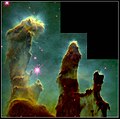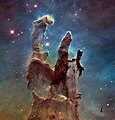File:Eagle Nebula - GPN-2000-000987.jpg
Appearance

Size of this preview: 606 × 600 pixels. Other resolutions: 242 × 240 pixels | 485 × 480 pixels | 776 × 768 pixels | 1,035 × 1,024 pixels | 1,944 × 1,924 pixels.
Original file (1,944 × 1,924 pixels, file size: 1.18 MB, MIME type: image/jpeg)
File history
Click on a date/time to view the file as it appeared at that time.
| Date/Time | Thumbnail | Dimensions | User | Comment | |
|---|---|---|---|---|---|
| current | 00:30, 3 October 2012 |  | 1,944 × 1,924 (1.18 MB) | Ras67 | losslessly cropped with Jpegcrop |
| 01:17, 9 April 2009 |  | 1,993 × 1,973 (1.45 MB) | BotMultichillT | {{Information |Description={{en|1=These eerie, dark pillar-like structures are columns of cool interstellar hydrogen gas and dust that are also incubators for new stars. The pillars protrude from the interior wall of a dark molecular cloud like stalagmite |
File usage
The following 3 pages use this file:
Global file usage
The following other wikis use this file:
- Usage on ar.wiki.x.io
- Usage on arz.wiki.x.io
- Usage on eu.wiki.x.io
- Usage on fa.wiki.x.io
- Usage on hu.wiki.x.io
- Usage on ka.wiki.x.io
- Usage on kw.wiki.x.io
- Usage on mk.wiki.x.io
- Usage on uk.wiki.x.io
- Usage on zh.wiki.x.io





